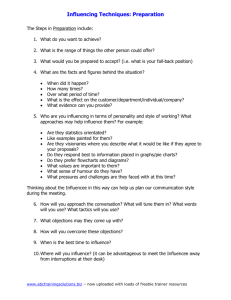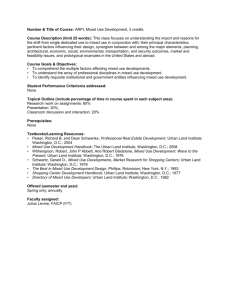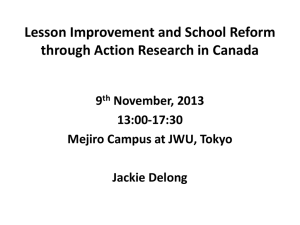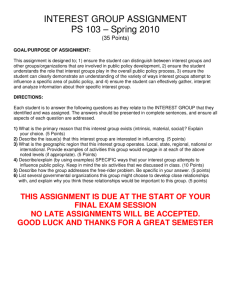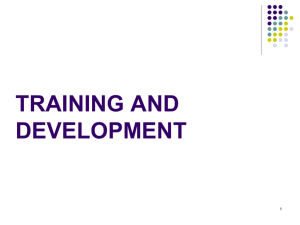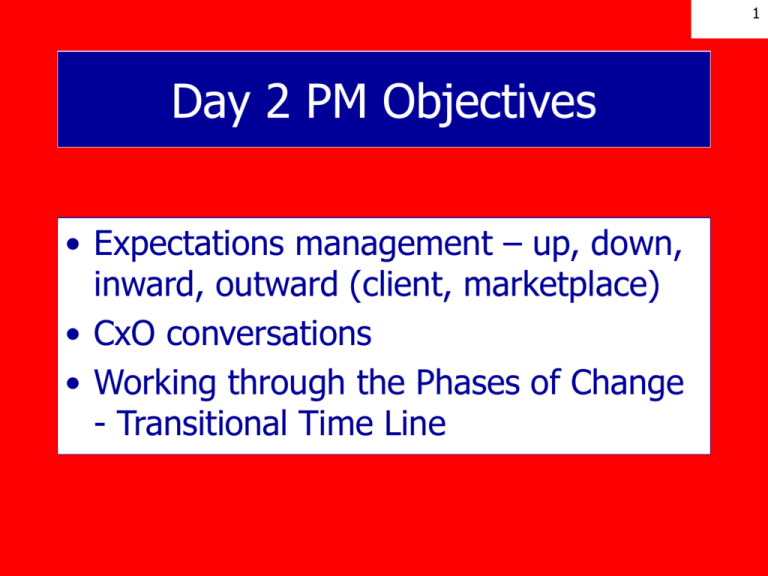
1
Day 2 PM Objectives
• Expectations management – up, down,
inward, outward (client, marketplace)
• CxO conversations
• Working through the Phases of Change
- Transitional Time Line
2
Expectations Management
• Understanding the Components of
the Influencing Process
• Laws of Expectations, Analysis &
Benchmarking, and Satisfaction
3
Motivational Theories
Needs
Individual Differences
Cognitive
Situational
4
Individual Differences
• People are believed to be different in 2
dimensions
– Achievement orientation
– Intrinsic motivation
• Contrast to Needs Theories
– Assumes individuals differ in strength of
various needs
5
Achievement Orientation
• Performance as a function of motive
strength and expectancy of goal
attainment
• Accounts for differences in levels of
effort
• One-goal and two-goal conditions
compared
– both groups assumed to have an aroused motive to achieve
– second group also had an added $5.00 bonus for a best
score on the task
6
Achievement Orientation
• Multi-incentive group performed better
– When achievement was the only goal, high
achievement motives performed better than low
• Performance is enhanced by multiincentive conditions
– Athletes should perform and attempt to achieve
multiple performance features (e.g., selfimprovement in technique, consistency of
performance, use of strategy, etc.) rather than to
focus on one item such as producing a best
performance
7
Intrinsic Motivation
• Effort proportional to enjoyment &
satisfaction
• Extrinsic rewards can backfire
– e.g., technical career anchor
• Feedback/informational rewards are
beneficial
• More emphasis on selecting for
predisposition
• Prescription: Ask
8
Motivational Theories
Needs
Individual Differences
Cognitive
Situational
9
Cognitive Theories
• Assume conscious decisions about level of
effort
• Three Theories
– Goal Setting
– Expectancy Theory
– ProMES
• Human behavior is not entirely rational
• Predictions are inaccurate
• Premium placed on L-F communications
– goals, performance standards, linkages
10
Goal Setting
• Assumes goals are most powerful factors in
determining motivation
• Determinants
–
–
–
–
specificity
difficulty
commitment
feedback
• Considerations
– avoiding conflict
– balancing attainability vs. difficulty
11
Goal Setting in Groups
• Discriminators
– specificity
– participation
– feedback
– combination of participation & feedback
– sensitivity to time limitations
12
Expectancy Theory
• Clarifies relationships between actions
and rewards
• Assumes
– motivated performance is a conscious act
– people will act to maximize rewards
• 3 factors determine motivation
– effort-to-performance expectancy
– performance-to-outcome expectancy
– valence
13
Expectancy Theory
Valence all outcomes
Environment
Effort
Performance
Outcomes
Ability
Expectancy performance-outcome
Expectancy effort-performance
14
Expectancy Theory
• Prescription for motivation
– Clarify links between level of effort and
project completion
– discuss positive outcomes
• to follower
• to organization
– clarify valences for completing project
15
Law of Expectation – Go above and beyond what is
expected to gain the influencing advantage.
#7 - The Law of Expectation
Your lowest standard should be their highest. Go above
and beyond what is expected and gain the influencing
advantage.
People are pleased when they get more than they anticipated.
They are disappointed if they do not receive what they expect.
.
16
Expectation
You need to create/refine expectations of others based
not upon your own desires but on what their view of your
capabilities and limitations are. Influence will be easier to
exert if you precisely understand the expectations of the
parties you are attempting to influence. The perception
of a win-win situation occurs when expectations are
shared and communicated well – especially when both
parties must give up points or compromise during the
influencing process, or when refinements of the
contracts are jointly negotiated and agreed upon.
Expectation and disappointment go hand in hand –
when expectations are not met, trust and faith are lost.
As trust dissolves – the power to influence decreases.
17
Law of Analysis And Benchmarking – People work
harder and are more motivated to accomplish goals when
they receive frequent feedback on their progress.
#2 - The Law of Analysis and Benchmarking
Sporting events have scoreboards for a reason.
People are inclined to work harder and remain more motivated to
accomplish goals when they are aware of and/or are given
feedback on their progress made on any goal, project, or task.
18
Analysis & Benchmarking
People need to know where they are in the goal
process. They often need validation for their
efforts in order to sustain their motivation and
stay on track. To achieve a high level of buy-in,
people need to know how their contribution
affects the entire system. It also helps to explain
the consequences of their participation or work
effort up front – good or bad. This can alleviate
conflict and conserve your leadership energies.
19
Law of Satisfaction & Standards – It is easier to persuade
people when you help satisfy them, while they remain true to
their ideals and maintain their standards.
#16 - The Law of Satisfaction & Standards
Follow the directions on your self-made map.
When we compromise and accept less than what we truly desire, we are
seldom fulfilled. Trust your instincts; go with your gut reactions—only you
know what you actually want,how important it is to you to get exactly what
you envision,and how you want to achieve your dreams. Remain true to
your ideals, maintain your standards, and only then will you be truly
satisfied.
20
Satisfaction
Unwillingness to settle for anything less than your
established criteria. When attempting to influence,
determine what the other individual’s criteria is and
deliver it to them (or make certain they believe that you
will be able to deliver it to them). Once satisfaction is
fulfilled, the person’s “seek” mode will cease to exist.
When this happens, the subject of your influencing
strategy is ‘taken out of play’. Your competition is
nullified or quashed.
Note: If criteria is compromised or changed, and you as the
influencer have not altered your tactic accordingly, ultimate
satisfaction will not be reached. The ability to influence will be
severely decreased.
21
Law of Image – People are more likely to interact with
people they are attracted to and who have an appropriate
appearance for the setting or situation.
#10 - The Law of Image
Opinions are formulated regardless of facts. Look
the part you are playing in life.
People are more likely to interact with others whom
they find to be attractive and acceptable/appropriate in
appearance.
22
How Does the Executive Expect
you to look?
• How can you overcome any
incongruency in what they expect?
Download the Notes for
the Influencing Process
Go to 21Laws.com
The Influencing Process white paper
will be automatically sent to you
when you sign up to receive the
Indaba Influence & Inspiration
Newsletter each month
23
24
The Influencing Process Flowchart
Step 4
Hierarchy of decision-making/authority.
Who has 'go ahead' power?
Who has 'veto' authority?
Step 1
Determine the desired outcome
Even though we can
chart the components
of the Influencing
Process and wrap
structure around it,
the Influencing
Process remains fluid
and constantly
changes. The
Influencing Process
adheres to many of
the Theories of
Chaos.
Step 2
Examine opportunities and pitfalls
Step 3
Be clear, concise, and specific
Detail precisely what you want
Step 5
Examine historical behavior/attitudes.
Step 7
Do a Gap Analysis.
Compare where you are
to where you need to go.
Step 8
Strategize to satisfy
Step 6
Analyze your current position
Step 9
Track your progress.
Evaluate/analyze/benchmark
consistently.
Step 10
Be flexible - change what you
are doing if it is not working.
Step 12
Make sure your message 'Sticks'
Step 11
Tune your sensory acuity to rcognize when you are in trouble
or when you are finished
Step 13
What did you learn?
1. Celebrate successes &
2. Analyze failure.
Copyright @2004 Hellen Davis, CLU
World rights reserved.
Duplicating in any form without written
permission expressly forbidden.
25
Influencing Process
1. Determine the desired outcome.
What is your goal?
Analyze your current state
with a perfect world view.
Shoot for the stars – if you
hit the moon, it’s still a
great accomplishment!
26
Influencing Process
2. Examine opportunities and pitfalls from
all stakeholder positions.
Examine
the cost/benefits: How can you reduce risk,
maintain long-term relationships and/or increase
profitability?
Rarely in negotiations is it a win/win for both parties.
Think Big Picture: Ask yourself, “Is this a battle you
need to fight (right now) to win the influencing war?”
27
Influencing Process
3. Be clear, concise, and specific on
the details of the outcome.
Determine
the desired outcome that embodies
agreement between all parties.
Determine
the ending phase that you want to
move them to on the Transitional Timeline.*
* To be discussed later in the course
28
Influencing Process
4. Determine the hierarchy of the
stakeholders perceptual positions.
Which perceptual position is most
important in this situation?
What are the risks in failing to establish this
pecking order before trying to influence?
29
Influencing Process
5. Analyze your current/present state.
Where are you today?
Make
certain you inspect the present state (current
circumstance) from all three perceptual positions*.
Be sure that you are looking at the situation from as close to
reality as possible. This should be analyzed without rose-colored
glasses.
Make certain you analyze the degree of trust between parties.
Note: There may be more than one entity or person's viewpoint in
each of the 2nd and 3rd perceptual positions.
Examine where each person or party is on the Transitional
Timeline™.
* This will be discussed later in the course.
30
Influencing Process
6. Do a Gap Analysis.
How far away from
the goal are we?
How are we going to
close the gap?
31
Influencing Process
7. Examine historical behavior and attitudes.
Further analysis of the Perceptual Prisms:
What has this person (team or
department) done in similar situations?
32
Influencing Process
8. Map out the strategy to satisfy all
perceptual positions whenever possible.
Build
a logical case based on the phases of the
Transitional Timeline™ leading toward the goal.
Build a verbal battle plan based on convincer
strategies and language patterns.*
Take into account the analysis from pertinent
perceptual positions.
Plan for yellow flags and potential stoppers
throughout phases of the Transitional Timeline™ &
influencing process.
* To be discussed later in course
33
Influencing Process
9. Evaluate and benchmark consistently to
ensure your goal-tracking progress.
How will you determine/measure your progress?
How will others evaluate your progress?
Have you discussed your
expectations of the results?
34
Influencing Process
10. Have the behavioral flexibility to
change what you are doing, IF what
you are doing currently is not working.
What are my contingency plans?
35
Influencing Process
11. Tune your sensory acuity so that you
realize the EXACT MOMENT you reach your
outcomes during the influencing process.
Act
appropriately and congruently according to your
plan.
Know
when to stop talking. In sales, recognize a buying
signal and then close your prospect. When managing
people, be able to identify when your people grasp the
meaning of your words and stop talking. Identify when
people see your point of view and stop trying to convince
them.
Note: Too many people talk too long!
36
Influencing Process
12. Future Pacing to Ensure Stickiness*
Future pacing and on-going buy-in ensure that
people stay on track after the influencing goal has
been achieved.
The basic premise of future pacing: You bring up
anything that might have the person deviate from
the plan. Rehearse (Future Pace) what might happen
if something (or someone) might cause them to feel
reluctance in carrying out the actions you both
agreed were necessary for completing the goal.
Future pacing is designed to bring them back to the
commitment they made to you – even if you are not
in the room.
37
Influencing Process
13. Celebrate successes and analyze failure.
Look back at the original goal and where you
started. In hindsight, what would you have done
differently? How did you grow through the
experience? How did you enhance your
relationship with others? How did you make the
situation, person, team, and/or company better?
38
Executive Speak – Breaking the
Code
• Learn how to recognize language patterns
and work them into your influencing process.
• Tailor your words to match your strategy.
• Cause and effect – the effective way to
change behavior.
• Embedding commands – How to powerfully
direct people without dictating.
39
Language Patterns
By mastering psychological language patterns and
assertive word usage, you will be able to command
and recognize sentence structures that form the basis
for formulating beliefs as well as decision-making and
value judgment processes.
One of our goals is to learn to analyze other people’s
pre-taught responses – their communication habits
and patterns.
40
Powerful Verbs
Assertive language begins with the use of
powerful verbs. The spice of communication
is versatility of powerful word usage.
People are judged—positively or negatively
on their command of verbal and written
language.
41
Recognizing Cause & Effect
Recognizing and using cause and effect language patterns
Will enable you to:
1. Use a naturally occurring language pattern to
install suggestions
2. Speak in the way beliefs are organized in your
prospects mind
3. Powerfully strengthen your understanding of
and leading techniques and impact
Words that Imply a Cause and Effect Relationship
As, and, while,causes, since, during, forces, makes, invokes
Settles, stimulates, creates, brings to pass, verifies, kindles
determines, becomes
42
IF….THEN……
If you believe you can do a thing, you can do it.
CLAUDE M. BRISTOL
If you see yourself as prosperous, you will be. If
you see yourself as continually hard up, that
is exactly what you will be.
ROBERT COLLIER
43
Language Patterns
Embedded Commands
– Embedded commands are commands that fit into
the normal structure of a sentence without
drawing attention to their existence.
– Examples
Bob, trust me on this investment. Sarah, we need to
make a decision. Gerry, let’s make an appointment to get
together soon.
Bob, sit down at the head of the table. Sally, you sit next
to him. Holly, please bring the butter and set it next to
me.
Congruency is very important when you make
use of embedded commands.
BE CONGRUENT!
44
Ambiguities
Phonological or
analogical
ambiguities make
people stop. The
goal is to open the
door for an
appointment to
influence.
Notice the embedded
command and the
use of alliteration.
45
AMBIGUITIES
46
Test for Embedded Commands
Use this simple test to keep you on the right track:
1. Make certain that the verb you are testing is in the
present perfect tense.
2. Say any person’s name.
3. To test this, use the words that make up the
command combined with any person's name in front
of the command to ensure that the command is a full
sentence.
4. If the sentence that you have just created is a
complete sentence that can be used on its own,
then and only then, have you used an embedded
command.
Note: Always remember that any present tense verb ending in -ing
will not form an embedded command.
47
Language Patterns
Embedded Quotes
– Embedded quotes can be used in several
ways. The most powerful is in building
metaphors. Embedded quotes take on
the format of ‘mini-metaphors’.
– Example
While discussing the status of our new service
development with Mark, he asked me, “Why
don’t you focus on the doable and ensure
market readiness?”
48
Language Patterns
Embedded Questions
– Use embedded questions to hide a
statement or a request.
– Embedded questions are softer than direct
commands.
– Example
I’m wondering whether it’s possible for you to file
your expense vouchers on time?
Additional preludes to imbedded commands: I
(sometimes) ask myself if.…, I'm curious as to....
Someone (person’s name) asked me...
49
Language Patterns
Cause & Effect
– Cause and effect language patterns have
been used in our realm of interaction with
other people since birth. It is vital to
understand that our beliefs take the format
of cause and effect.
– Formula: X causes Y
*Generally, X is a pacing statement
(verifiably
true in your
prospect’s mind)
* Generally, Y is a lead (something different
than your prospect believes)
50
Law of Belief Replacement – People are willing to
change their beliefs ONLY when they are replaced by other
beliefs that are at least equally valid in their minds.
#3 - The Law of Belief Replacement
Make a suggestion, then introduce a solution
People are willing to change their beliefs ONLY if they are
replaced by another belief that is also true in their mind.
51
Belief Replacement
In order to change another person’s belief you
have to replace it with another belief. But, first
you must introduce doubt. The best way to instill
doubt is by injecting unknown information. For
example - That’s interesting, but I just read or
heard or saw… Then follow with a credible
cause and effect statement.*
*Discussed further in the language section
52
Language Patterns
Cause and Effect
EXAMPLE
Introducing new products causes industry analysts
to look more closely at how they perceive our
company
“It is the way we react to circumstances that
determines our feeling.”
DALE CARNEGIE
53
Language Patterns
Implied Cause & Effect
– Implied cause and effect patterns are less
detectable in conversation than direct
cause and effect patterns, but have
exactly the same effect on your
prospect's mind.
– Formula: As X, Y
54
Language Patterns
Implied Cause and Effect Examples
You always do what you want to do. This is true with
every act. You may say you had to do something, or that
you were forced to, but actually whatever you do, you
do by choice. Only you have the power to choose for
yourself.
W. CLEMENT STONE
These, then, are my last words to you: Be not afraid of
life. Believe that life is worth living and your belief will
help create the fact.
WILLIAM JAMES

